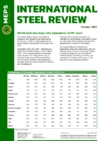Red Sea attacks stall return of safe shipping routes
The sinking of two cargo vessels in the Red Sea ended steel importers’ earlier hopes that the busy shipping route’s return to normal service would reduce steel transport costs this summer.
Houthi rebels followed their July 6 attack on the Greek-operated bulk carrier Magic Seas with the sinking of a second ship, the Eternity C, on July 9. These were the first cargo ships sunk while en route to the Suez Canal during 2025.
The renewed attacks came less than a month after French shipping line CMA CGM became the first shipping provider to navigate the Suez Canal since March 2024. According to Lloyd’s List data, shipping volumes through the Red Sea remain 60% below those before the Houthi rebels’ cargo ship attacks started.
The Yemen-based Houthis said that this month’s violence was a response to shipping companies’ alleged violation of their ban on calling at Israeli ports.
On July 10, the day after the sinking of the Eternity C, MEPS respondents said that the freight cost from China to Turkey had risen by 43% week-on-week.
Nonetheless, the continued Red Sea conflict is not expected to significantly affect Asia-EU shipping. Most exporters will continue to use the longer route around South Africa’s Cape of Good Hope.
Shipping challenges add to Asia’s tariff concerns
Neither did the attacks stall the price decline recently indicated by the Drewry's World Container Index (WCI). The WCI fell by 2.6% week-on-week, to USD2,602 per 40-foot container, during the week to July 17 – its fifth consecutive weekly decline. This follows a shipping price spike created by the front-loading of exports ahead of President Trump’s initial July 9 deadline on US “reciprocal” import tariff negotiations.
The volatility of shipping prices is an added hurdle for Asian steel exporters already feeling the effects of the United States’ import tariffs. US Section 232 import tariffs of steel were doubled, to 50%, on June 4. Furthermore, many downstream products will also be affected by the outcome of negotiations over “reciprocal” import tariffs. The deadline for these negotiations is now August 1, with China’s negotiations with the US set to come to an end on August 12.
- This article was first published in MEPS's International Steel Review. The monthly report provides subscribers with steel prices, indices, market commentary and forecasts from key global steel markets. Contact MEPS for details of how to subscribe.
In recent weeks, President Trump issued letters to various nations, many with threats of higher tariffs if negotiations are not successfully concluded. To date, the Trump administration has announced provisional trade deals with Indonesia and Vietnam.
Without reductions to the Section 232 tariff, however, many Asian steel producers will aim to divert some of their exports to the EU. MEPS respondents in the EU said that certain Asian suppliers had reduced their prices to negate the cost of duties incurred as a result of recent revisions to the EU import safeguard measures’ tariff-rate quotas. From January 1, 2026, these suppliers will also have to mitigate the cost of the CBAM taxes, however.
Export challenges to exacerbate Asia’s oversupply
Many Asian countries need to maintain exports as their domestic markets become oversupplied amid low demand and pressure from low-cost Chinese material. China’s steel exports grew by 9.2% year-on-year in the first half of this year, reaching 58.2 million tonnes, according to the China Iron and Steel Association (CISA).
MEPS’s July research revealed that market participants in Taiwan are increasingly anxious about this threat of oversupply, given the ongoing US trade negotiations. In 2024, 756,684 tonnes of Taiwanese-origin steel was imported into the US, making it the nation’s fourth-largest source of Asian steel. On July 3, Taiwan's finance ministry imposed antidumping duties as high as 20.15% on Chinese hot rolled coil and sheet.

Source:
International Steel Review
The MEPS International Steel Review is an essential monthly publication, offering professional analysis and insight into carbon steel prices around the world.
Go to productRequest a free publication





